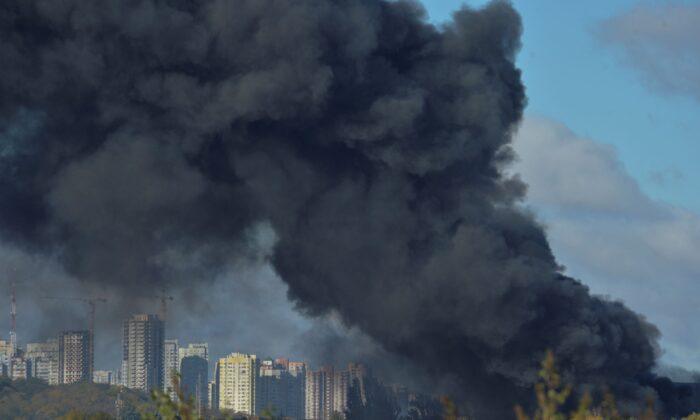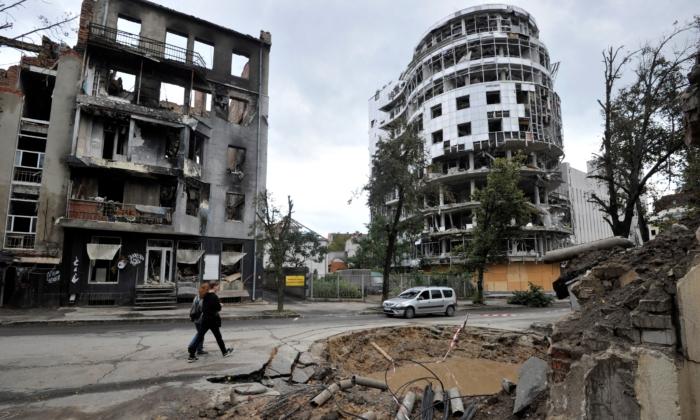The Ukrainian war has entered a second, more dangerous phase.
This phase is marked by a significant Russian escalation of hostility, a call up of roughly 300,000 reservists, renewed Kremlin threats that all options are on the table, including the potential use of theater nuclear weapons and a Russian declaration that, following a plebiscite, the Donetsk, Luhansk, Kherson, and Zaporizhzhia regions of Ukraine have been annexed to Russia. The Kremlin has subsequently announced that further Ukrainian advances in these territories would constitute an attack on Russian territory.
“Russian cruelty in the Ukraine War to this point has had the feel of standard operating procedure, rather than any conscious state effort to inflict human suffering. That now appears to be changing. Surovikin’s elevation to theater commander means Putin has decided war crimes are no longer to be casual, but deliberate. No longer incidental, but celebrated.”
As the Ukrainian war shifts to a more brutal, “Chechen war-like” phase, the likelihood of an exit ramp that could bring the fighting to an end continues to recede, and the probability of continued escalation, a potential spillover into NATO territory, and unintended consequences continues to increase.
On Oct. 8, a truck bomb exploded on the Kerch Strait Bridge. The 12-mile structure connects Crimea with Russia and is a vital supply line for Russian military forces in southern Ukraine. The truck bomb ignited several railcars full of fuel and damaged portions of the bridge. As of Oct. 10, the bridge appears to be functioning but at a reduced capacity. Kyiv has not taken credit for the attack. The Kremlin branded the assault an “act of terrorism” and responded with a barrage of cruise missile attacks against Ukraine’s principal cities.

Simultaneously, Ukrainian forces advancing toward Kherson and Nova Kakhovka are getting close to the sluice gates controlling water flow from the Dnieper River to the Crimean Canal. The canal is Crimea’s principal water source and is vital to maintaining agricultural production in that region. The combination of cutting off Crimea’s water source and further damage to the Kerch Strait bridge would make Russia’s position in Crimea extremely difficult in the short term and unsustainable in the long term. In tandem, the two events would precipitate a further escalation from Russia.
The escalation of the Ukrainian conflict is occurring as a closer working relationship—if not a de facto political, diplomatic, and military alliance—is developing between Russia, China, Iran, and North Korea. Dubbed Warsaw Pact 2.0, the alliance’s existence was underscored at the recent summit of the Shanghai Cooperation Organization when Russia and China declared that they fully supported each other’s foreign policy agenda.
The Historical Parallels
Historians have long debated which events marked the beginning of World War II. Was it the Japanese seizure of Manchuria, Italy’s invasion of Ethiopia, Adolf Hitler’s annexation of Austria, or his seizure of the Sudetenland and the eventual absorption of all of Czechoslovakia?All these events were dramatic escalations of violent aggression by a powerful country against a weaker opponent. However, none of these conflicts needn’t have led to a worldwide war. They were regional conflicts and could easily have remained that way.
What transformed a series of unrelated and local conflicts into a world war was the Japanese attack on Pearl Harbor on Dec. 7, 1941. In the aftermath of that attack, Hitler, who felt that Germany was already in an undeclared war against the United States (one being fought by British and Commonwealth proxies), declared war against the United States. Benito Mussolini followed soon after.
Neither country was obligated to go to war with the United States. The Axis Treaty between Germany, Italy, and Japan was intended to be a defensive alliance. It specifically excluded the obligation to declare war if a member was the aggressor. Nonetheless, Germany and Italy declared war on the United States.
In doing so, they linked a series of regional conflicts into one worldwide conflagration that brought American military forces, and to a slightly lesser extent British and Commonwealth military forces, into the multiple military theaters of a global war.
Fast forward some 80-plus years later. The four countries most determined to change the global order are increasingly linked together in a de facto alliance. None of them have a specific mutual defense treaty that formally binds them together. Beyond a desire to rewrite the post-war, American-led global system, they have little else in common and are often competitors in other regions of the world, especially in the Middle East/Persian Gulf and in Central Asia.
Three of those four countries have nuclear weapons. Iran will soon have them. China, Russia, and Iran are staging increasingly larger joint military exercises. North Korea and Iran are supplying military equipment and munitions to Russia slated for the Ukrainian war.
While it does not appear that China is supplying any armaments to Russia, it has emerged as the principal market for Russia’s commodity exports, especially oil and gas. Without access to China’s market for its commodity exports, the Russian economy would likely collapse.
The current state of cooperation does not mean that the four countries are contemplating or will carry out coordinated military actions. It does mean, however, that the United States and its allies must consider such coordination a real possibility.
Moreover, even if there isn’t any explicit coordination, a conflict in one region, and the likelihood of U.S. preoccupation with it, might spur military adventurism elsewhere.
The recent stepped-up missile tests by North Korea are a case in point. The missile drills are meant to mimic both a conventional and nuclear strike against South Korea, Japan, and U.S. naval assets in the region. It’s not a coincidence that Pyongyang’s recent aggressiveness is occurring when the Ukrainian war is entering a new, more dangerous phase.

Likewise, a nuclear-armed Tehran will precipitate a nuclear arms race in the Persian Gulf, adding an additional layer of complexity and risk to the region’s geopolitics. It’s long been rumored that Saudi Arabia was heavily involved in funding Pakistan’s nuclear development program on condition that Riyadh could obtain such weapons from Islamabad should it ever want any. Tehran’s nuclear monopoly in the Gulf will likely be very short-lived.
Is US Ready for a Multi-Conflict Global Crisis?
How a possible Chinese invasion of Taiwan might impact the regional ambitions of Russia, Iran, and North Korea is unclear. Regardless of whether any of those countries have foreknowledge of Beijing’s plans, it’s likely that they would take advantage of the resulting situation to advance their agendas.Even without any explicit planning or coordination, it’s probable that multiple incidents of aggression, or at the very least aggressive behavior, would occur relatively simultaneously. All those incidents would draw in the United States. In short, U.S. military forces could find themselves engaged or on high alert in multiple conflicts around the world. In short, a worldwide crisis!
Whether such a scenario is probable is anybody’s guess. It’s certainly possible, and it’s unquestionably a scenario for which the United States should be prepared. That begs the question: Are U.S. military forces capable of simultaneously engaging in multiple theaters of operation, and significantly, does the Pentagon have enough reserve capacity to replace its losses and remain engaged in multiple theaters?
Naval power would play an important role in any conflict in the Sea of Japan (Korea), the East and South China seas (Taiwan), and the Persian Gulf (Iran). Such conflicts would also likely involve using significant firepower, possibly nuclear, to create area denial zones for the U.S. Navy and could precipitate significant losses of naval assets.

Could the U.S. Navy continue to effectively project military power in multiple theaters under these circumstances, especially if U.S. naval forces were also being used to simultaneously protect critical shipping from attack by unconventional forces or disrupt Chinese maritime supply lines? Given the current depleted state of the U.S. Navy, the answer is no.
Airpower would also play a critical role. The United States has airbases staged around all these potential conflict zones. With aerial refueling, it also can project airpower anywhere in the globe from bases in the United States. Conducting worldwide operations from domestic U.S. bases, however, is hard on crews and airframes and a heightened operational tempo is not sustainable over the long term.
Moreover, you can’t win a war with just airpower, recent experience in the Balkans notwithstanding. At best, in the event of a regional conflict, U.S. airpower could slow down an aggressor’s advance, disrupt their timetable, and hinder their ability to concentrate their offensive assets. Such actions will buy time, but not a victory. Could the United States sustain a heavy schedule of air operations over multiple theaters of conflict simultaneously? Probably in the short term, assuming supplies are sufficient, but not in the long term.
Ditto for U.S. ground forces. The United States has small but significant ground forces in these possible theaters of conflict. But these forces are meant to serve primarily as a trip wire and to guarantee a continued military commitment and presence by the United States. While important, they would likely be dwarfed by the ground forces that each of these aggressors could bring to bear, although local allies would offset part of that disadvantage.
Simply put, the growing de facto alliance between Russia, China, Iran, and North Korea could create a situation where the United States finds itself simultaneously embroiled in multiple global conflicts. Whether you choose to call such a scenario a world war or World War III is irrelevant. The important question is whether the U.S. military can simultaneously respond on a global basis to multiple conflicts and sustain its presence there, considering the expected losses. The answer is probably no.





